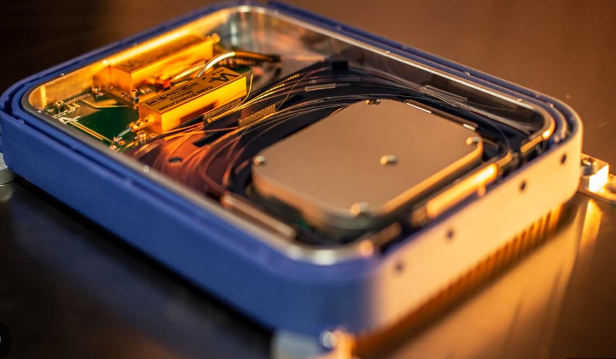Blog Credit: Trupti Thakur
Image Courtesy: Google
Portable Sea Based Optical Atomic Clock
Atomic clocks are the backbone of the Global Positioning System (GPS), the network of satellites above the earth that we use every day to navigate cities, respond to emergencies, and organize military operations, among other things, and there have been recent improvements in this area. Not only are these devices important for navigation, but they are also used in military actions and case of emergencies. In the past, these timekeeping devices were big and only used in labs. More recent research has worked on making smaller versions that can be taken anywhere.
Despite being one of the most accurate timekeeping methods, however, there is still room for improvement. Scientists today are pushing the boundaries with a new technology called optical atomic clocks.
About Atomic Clocks
- An atomic clock is a highly accurate clock that functions by utilizing specific resonance frequencies of atoms, typically cesium or rubidium.
- Invention:Invented in 1955 by Louis Essen.
- Precision:Atomic clocks are so precise that they lose only one second approximately every 100 million years.
The Working of an Atomic Clock
Some atomic clocks, like those that use the isotope caesium-133 (Cs-133), work by measuring the microwave radiation that is received when Cs-133 atoms change between two energy levels. The second is defined by the exact frequency of this energy. Because of this process, these clocks can keep a very accurate time. For example, caesium atomic clocks only lose one second every 1.4 million years.
How Optical Atomic Clocks Differ?
Optical atomic clocks are a huge step forward in terms of accuracy. Atomic changes are set off by lasers instead of microwaves in these clocks. Usually, strontium or ytterbium are used. Because optical transitions happen more often, these clocks can count more cycles per second. This lets them measure time more accurately and get smaller line widths for even more accuracy.
Building a Portable Optical Atomic Clock
A new study in the journal Nature goes into depth about how new technologies have led to the creation of portable optical atomic clocks. Molecular iodine is used in these new clocks, which are small enough to be put on ships and have miniature parts like spectrometers and laser systems. Even though they are less accurate because they are smaller and easier to carry, these maritime optical clocks are still much more accurate than other choices for keeping time on boats.
This innovative clock, while trading some accuracy for portability and robustness, still surpasses existing vessel-borne timekeeping options in precision.
Importance of Atomic Clocks
- GPS Backbone:Atomic clocks are crucial for the Global Positioning System (GPS), essential for navigation, emergency response, and military operations.
- Accuracy:Traditional atomic clocks, such as those using caesium (Cs-133), offer unparalleled accuracy, losing or gaining only a second over 1.4 million years.
Advancements in Optical Atomic Clocks
- Higher Precision:Optical atomic clocks, operating at optical frequencies, are even more accurate, with stability enhanced by lasers and coherent light.
- Smaller Increments:Higher operating frequencies allow these clocks to measure smaller time increments more accurately.
- Narrow Linewidths:The narrow linewidths of optical transitions enable precise frequency tuning, further enhancing accuracy.
Portable Optical Atomic Clock Design
- Miniaturization:Researchers created a compact clock using molecular iodine as the frequency standard, fitting it into a standardized rack.
- Components:The clock’s design includes a miniaturized spectrometer (2.5 liters), a laser system (1 liter), and a frequency comb (0.5 liters).
- Autonomous Operation:Equipped with software for autonomous initialization and operation, the clock monitors temperature, activates components, and maintains stability.
Performance and Testing
- Laboratory Tests:Initial tests at the U.S. National Institute of Standards and Technology (NIST) demonstrated superior performance compared to traditional hydrogen maser and rubidium atomic clocks.
- Maritime Tests:The clock was tested on a boat at Pearl Harbor, Hawaii, maintaining stability despite environmental challenges like motion, temperature fluctuations, and humidity changes.
Applications and Implications
- Maritime Navigation and Communication:The portable optical atomic clock can enhance precision in maritime navigation and communication systems.
- Scientific Research:Potential applications include monitoring underwater seismic and volcanic activity and conducting space-based experiments to test theories of relativity.
- Reduced Satellite Costs:Improved timekeeping accuracy could reduce the cost and enhance the precision of satellite-based navigation.
Conclusion
The development of a portable optical atomic clock represents a significant advancement in timekeeping technology, offering improved accuracy and robustness for maritime and scientific applications. This innovation paves the way for more precise and reliable navigation, communication, and research capabilities, both at sea and in space.
Types of Atomic Clocks:
- Cesium Atomic Beam:Known for high accuracy and good long-term stability.
- Hydrogen Maser:Best stability for periods of up to a few hours.
- Rubidium Gas Cell:Commonly used type of atomic clock.
Blog By: Trupti Thakur

13
JunPortable Sea Based Optical Atomic Clock
Jun 13, 2024Recent Blog
The Web Privacy ValidationMay 27, 2025
India’s First Creator LandMay 21, 2025
Tokenization – An Initiative By RBIMay 20, 2025
The BioMetric E-PassportsMay 19, 2025
AI HallucinationsMay 16, 2025




